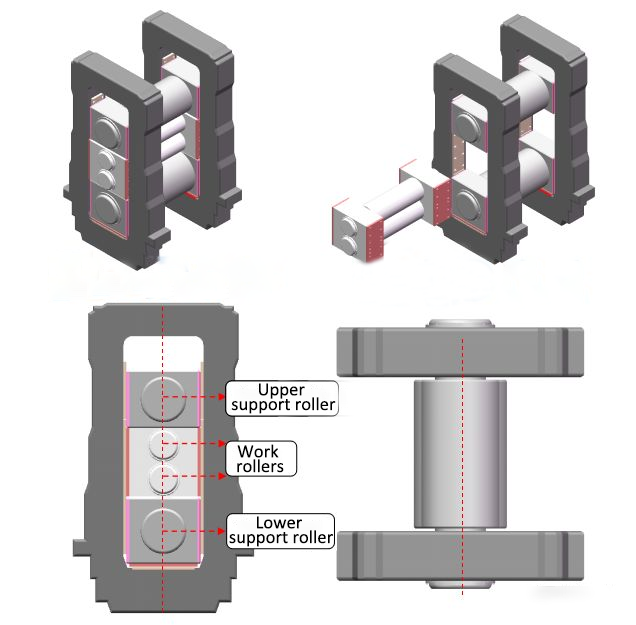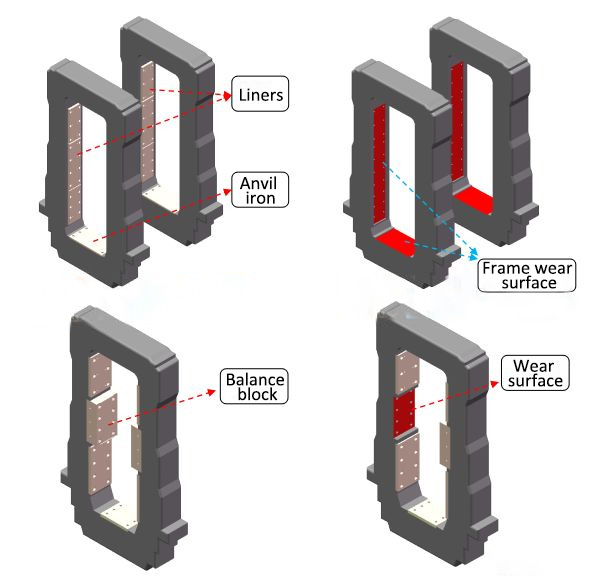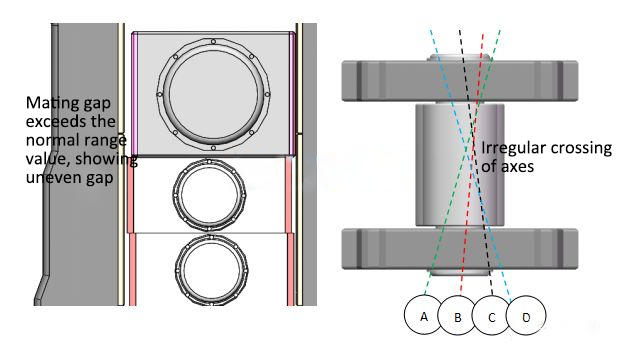A, The normal working rolling mill state
The window size of the new mill plate is often within a certain tolerance range, generally speaking, the window size tolerance is often in the range of +0.3 – +0.7mm, for the mill roll bearing seat to establish a stable and accurate position.
B, The mill plate wear position and cause analysis
1. Wear position
(1) The upper and lower support rolls, work roll liner and rack mating surface.
(2) Anvil iron and rack mating surface.
(3) Balance block (or bending roller device) and the rack mating surface.
2. Analysis of the causes of mill plate wear
(1) Cooling water corrosion.
As the mating surface between the liner and the workshop is a metal-to-metal fit, the metal in the processing process even if it reaches a fairly high surface finish and flatness, but the two components in the fit can not reach 100% fit, which will cause the gap between the mating surface. During the production process, cooling water will enter the liner plate and the mating surface gap of the mill, the cooling water will cause corrosion on the surface of the mill plate, forming a layer of oxide, so that in the rolling process, the liner plate will cause tight pressure on the loose oxide layer pat, etc., so that the gap will further increase, which will lead to corrosion and wear of the plate itself more and more serious, until the impact of the quality of the rolled products. The corrosion of circulating cooling water on the mill plate, is one of the most important reasons for the corrosion and wear of the rolling plate.
(2) Metal fatigue wear.
Rolling mill plate workshop operation process by the constant impact of the force in all directions, the liner itself and the liner and the mating surface of the plate workshop will produce normal metal fatigue wear, which is caused by the characteristics of the metal itself.
(3) Surface roughness.
Surface roughness directly affects the mating area between the liner and the frame, the surface mating surface after milling machine processing is only about 50%, and the mating surface after grinding machine finishing can generally reach about 70%. With the smaller the area, the greater the pressure per unit area, the shorter the cycle of metal fatigue wear, the shorter the service life.
(4) Rack deformation.
Bearing seat on the mill stand continuous impact coupled with the corrosion of the liner surface, can quickly lead to the support part of the deformation. Due to this increased spacing, the bearing seat is given more freedom of movement. After examining many mill stands we noted that the increase in clearance gap is inconsistent throughout the height of the stand, with the largest gap occurring below the rolling line. There is also a noticeable difference between the drive side and the operator side. (b) This excessive movement combined with changes in position caused unwanted vertical deviations, which resulted in work roll crossings.
(5) Loosening of bolts fastening the liner during mill operation.
The liner fastening bolts need to be inspected and tightened regularly, and the normal inspection time should be when the rolls are replaced. Due to equipment management problems, the fastening bolts are not effectively and timely tightened, the liner plate and the mill plaque will produce a certain gap between them, so that during operation, the liner plate produces a certain pat on the plaque itself, leading to metal fatigue on the surface of the plaque in a short time, which in turn causes wear and tear of the plaque.
(6) Vicious circle.
The permanent deformation of the mill stand surface brought about by the continuous impact load will be further worsened by the corrosive deterioration of the material. When the liner starts to move, the fixing bolts will loosen and fail to hold the liner firmly in the frame. This creates an opportunity for emulsions, steam and contaminants from the rolling process to enter behind the liner, thus increasing the corrosion efficiency of the material on the back of the liner and the paddle itself.
C, The impact of mill plate wear produced by
1. Excessive clearance.
During the rolling process, the bearing seat of the support roll, work roll and the liner plate on the plate on the mating surface gap increases, forming a kind of “slap” on the frame, intensifying the fatigue wear of the frame, resulting in unstable operation of the equipment, vibration is intense.
2. Support rollers, work rollers axis cross.
The continuous impact of the bearing seat on the mill stand plus the increase in fatigue wear on the surface of the stand can quickly lead to deformation of the support section. Due to this increased spacing, the bearing seat is given more freedom of movement. Upon inspection we noted that many mill stand clearance gap increases are inconsistent throughout the height of the stand, with the largest gaps occurring below the rolling line. There was also a noticeable difference between the drive side and the operator side. This excessive movement combined with changes in position caused unwanted vertical deviations, which resulted in work roll crossings.
3. Poor sheet quality.
The product rolled by this excessively worn mill will have a sheet product with undesirable surface condition when measured, and arching will be detected in the sheet length direction, reducing the rolled length. It will affect the thickness dimension and plate shape of the plate strip, which will affect the downstream user’s use effect. Thickness fluctuations in length and wedge dimensions in cross-section can occur. The plate shape will produce wavy defects, making the strip shape inconsistent with the normal rolled plate shape. Severe changes in plate shape can also produce mill rejects, resulting in increased mill line downtime and consumption.
Post time: Jan-30-2023



